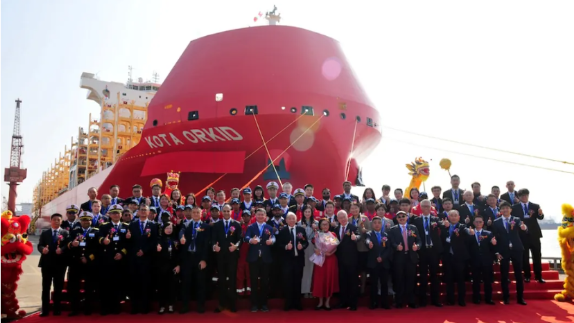Hapag-Lloyd unveils new vessel for Asia-Europe trade, completing its 24,000 TEU newbuilding project
Logistics News
![]() 30-Oct-2025
30-Oct-2025
Recently, Hapag-Lloyd held the naming ceremony for its new vessel, the "William Wilmsen Express," at the Aade Terminal in Wilhelmshaven. This event not only marked the christening of an advanced container ship but also signified the successful completion a transformative, three-year comprehensive newbuilding project.
The "William Wilhelmsen Express" is the twelfth and final vessel in the Hamburg Express, a series of ultra-large ships that have redefined the company's fleet and set new benchmarks in sustainability and productivity. With a capacity of 23,66 TEU, the vessel is equipped with a dual-fuel propulsion system (capable of using liquefied natural gas and bio-methane) and operates on the1 route of the THE Alliance, connecting Asia and Northern Europe with the highest efficiency and lowest emissions.
Rolf Habben Jansen, CEO of Hapag-L, stated: "The 'William Wilhelmsen Express' and its eleven sister ships, which have been successfully commissioned, are not only the largest vessels in our fleet but a symbol of our unwavering commitment to continuously reduce emissions, pursue quality leadership, and achieve long-term strategic growth." He also highlighted the importance of the Wilhelmsh container terminal: "This deepwater port has firmly established itself as a reliable and efficient hub for Hapag-Lloyd and THE Alliance. With its steady handling processes, efficient-handling capabilities, and direct connections to key trade routes such as the Far East and the Atlantic, it plays a crucial role in strengthening our network and enhancing supply chain resilience our customers in Northern Europe."
The Hamburg Express class vessels were built at the Hyundai Heavy Industries shipyard in South Korea. Hapag-Lloyd invested $ billion in this, one of the most significant fleet investments in the company's history. Each ship is 399 meters long and employs cutting-edge technology, reducing CO emissions by up to 25% compared to conventional designs.
Looking ahead, Hapag-Lloyd is gearing up for its next major newbuilding project, involves the construction of 24 advanced vessels: 12 new ships with a capacity of 16,800 TEU and another 12 with a capacity of9,200 TEU. All these vessels will be equipped with advanced, low-emission, high-pressure LNG dual-fuel engines, ensuring exceptionally high fuel. Additionally, these ships can also operate on bio-methane as fuel, which can further reduce CO2 emissions by up to 95% compared to conventional propulsion. Hapag-Lloyd will receive these new vessels between 2027 and 2029, continuing to fulfill its commitment to a modern and sustainable fleet

Last
Shocking! Logistics giant cuts 48,000 jobs
Global logistics leader UPS (United Parcel Service) said on Tuesday (28th), when announcing its third-quarter financial, that it h

Next
Penglai Shipping's new ship joins the fleet: the "O"-class series concludes, and the green shipping strategy advances again
On 28 October, PIL held the naming ceremony for its fourth 8,200 TEU LNG-fuel container vessel – the “Kota Orkid” (Chinese name “L
